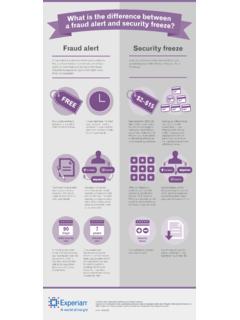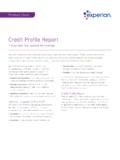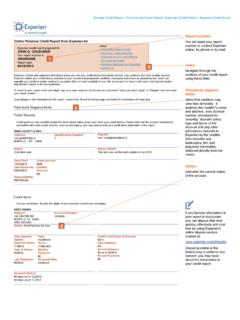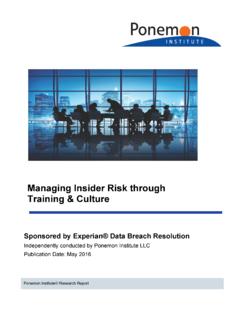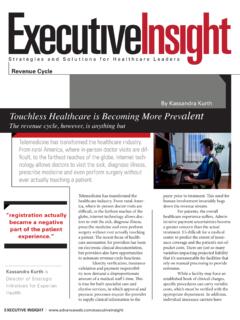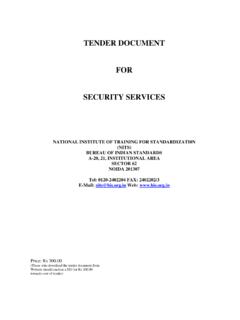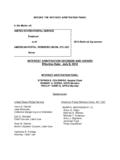Transcription of The 2018 Global Fraud and Identity Report - experian.com
1 The 2018 Global Fraud and Identity ReportExploring the links between customer recognition, convenience, trust and Fraud riskPage 2 | Being recognised is a simple thing that goes a long way. Recognition takes many forms whether it s acknowledgement for an achievement or being welcomed in a room as a familiar face. It feels good to be recognised. But there s more to recognition than feeling good. Now more than ever there s a commercial value associated with it. In an increasingly digital world, we are trying to recreate in-person recognition across industries and channels to fuel growth and opportunities. In doing this we need to carefully balance customer security and convenience with Fraud and friction. Being able to verify someone shouldn t disrupt the way they interact with a business.
2 experian believes that any business that can better identify its customers can more easily spot Fraud . IntroductionExecutive SummaryJust how well-equipped are businesses at recognising their customers identities online? What type of investments are they making in customer recognition and to what degree are they able to accurately identify customers and manage Fraud risk? Our 2018 Global Fraud and Identity Report , based on input from more than 5,500 consumers and 500 businesses* worldwide, looks at this topic to understand what consumers think of security protocols today and gauges how confident businesses are in their ability to accurately identify their customers.* Businesses in one of the following sectors: retail banking and credit card, digital only and click-n-mortar retailer, airline industry, consumer technology and electronics, telecommunications worldwide (Australia, Brazil, China, France, India, Singapore, South Africa, Spain, Turkey, the United Kingdom and the United States).
3 | Page 3 Online activities among consumers reflect widespread embrace of digital commerce as a way to purchase goods and services (90 percent) and conduct personal banking (88 percent) (Figure 2). As businesses undergo digital transformations in their front and back office operations, they recognise the importance of trust and the need for technology to enable it. When it comes to online engagement, three-quarters (75 percent) of businesses are interested in more advanced security measures and authentication processes that have little or no impact on the customer. At the same time businesses understand that their customers take comfort in the security measures they already have in place for digital trust through technology without disruption is increasingly the goal, but also the responsibility of businesses with online channels.
4 While there are genuine barriers to achieving that goal, it is now more critical than ever to business most consumers owning smartphone and mobile devices (91 percent), followed closely by laptop computers (83 percent), the digital marketplace is here now (Figure 1). Certainly, technology is supporting the large volume of online interactions between businesses and consumers. But the real currency of digital commerce is trust. Executive Summary75% of businesses want advanced authentication and security measures that have little or no impact on the digital customer 1 Top activities on devicesOnline ShoppingPersonal BankingPlay Video GamesApply For Drivers' LicenseGet Quotes/Buy InsuranceApply For Credit Cards/LoansFile Taxes90%88%51%51%49%48%45%Figure 2 Device ownershipSmartphoneLaptopTabletPCSmartwa tchSmarthome Device91%83%65%62%21%13%Page 4 | Lack of visible security was the #1 reason customers abandoned a transaction53%47%27% abandoned a transaction due to a lack of visible reasons transactions were abandoned include.
5 Too much information required for new account setup Mandatory account creation for a one-time purchase Unclear reasons the site did not recognise meFigure 6 AbandonedDid not abandonThe enthusiastic embrace by consumers of the digital marketplace is predicated on trust. Four out of five consumers trust that businesses are making the protection of their personal information a top priority (Figure 3).Consumers expect businesses to protect themNonetheless, consumers are feeling reassured. They cite visual signs of security and barriers they encounter when accessing their online accounts as indicators that a transaction is more secure. In fact, the lack of visible security was the number one reason customers abandoned a transaction (Figure 6).
6 In contrast, almost three-quarters of businesses (72 percent) cite Fraud as a growing concern over the past 12 months (Figure 4) and nearly two-thirds (63 percent) Report the same or higher levels of fraudulent losses over that same period (Figure 5).63% of businesses have experienced the same or more Fraud losses in the past 12 months4 out of 5 consumers trust that protecting personal data is a top priority (banking)Figure 3 Figure 5 Business executives share a growing concern about Fraud over the past 12 months27%45%Slightly moreSignificantly moreFigure 4Q: In the past 12 months, how has your concern about the risk of Fraud changed, as it relates to your business? 33%27%30%Slightly moreThe same amountSlightly less 63% | Page 5 Nearly two-thirds (66 percent) of consumers surveyed appreciate security protocols when transacting online because it makes them feel protected (Figure 7).
7 In some ways, consumers tolerate the nuisance of common barriers to accessing their accounts ( , forgetting their password or having to re-enter other security controls like CAPTCHA or PIN code) concluding that higher friction means better security. Consumer tolerance for friction for the sake of security varies across the 11 countries surveyed. For example, consumers in India and South Africa are more tolerant of security protocols because it makes them feel protected. On the other hand, consumers in Turkey are less tolerant. Tolerance also varies by age. One-third of consumers surveyed said they would do more transactions online if there weren't so many security hurdles to overcome. Among these consumers, 42 percent were millennials compared to only 30 percent of those 35 and older.
8 In other words, younger consumers are less tolerant of security hurdles and are more inclined to engage online if there was less for businesses, there is a delicate balance to achieve. They need to deliver an online experience that instills confidence, with security protocols that make customers feel safe and protected. And, they need to allow for easy and convenient the differences in tolerance for friction across different markets and age groups, a Global one-size-fits-all solution is difficult to achieve. It is also a moving target, as consumers tolerance for friction could lessen over time. Not to mention the expectations for a frictionless experience among future generations of digital customers used to an online digital experience that imposes few, if any, visible security security protocols transition to more data-driven, artificial-intelligence powered systems operating behind the scenes, businesses will need to gain and maintain the customer's trust without the familiar perception of security.
9 Solutions that combine device information with other data points such as biometrics could help businesses in the future better recognise their customers rather than challenging them. 42% of millennials said they would conduct more online transactions if there weren t so many security hurdles to ..versus 30% among those 35 and older We re starting to look at what are the other ways biometrics could be used. There is a world out there that is quickly evolving. Strategist, retail banking, United States66% of consumers said, "I like all the security protocols when I interact online because it makes me feel protected."IndiaS. keyOverall64%63%63%62%56%66%Q: Please indicate how strongly you either agree or disagree [with each of the following statements] on the scale provided - disagree strongly, disagree, neither agree nor disagree, agree, strongly 7 Page 6 | Businesses are aware of the prevalence of Fraud in the marketplace, and the degree to which fraudulent activity has an impact on their business.
10 In fact, Sixty-five percent of businesses are detecting the same or more fraudulent activity (Figure 8). Why has Fraud become so pervasive and why have businesses struggled to keep up? The great irony is that the weapon against online Fraud is also the source of its vulnerability. The existing account setup process requires consumers to provide extensive personal information, answers to secret questions and passwords. Data breaches have exposed this information to fraudsters. Once stolen, this information can be used to facilitate fraudulent activity, giving personal information genuine value in illicit markets. As the potential windfall from digital Fraud grows, so does the cybercriminal s motivation to stay ahead of the latest detection strategies and businesses seems increasingly daunted by the task Our systems are not good partly because we're taking three different sets of systems and combining them into one.
